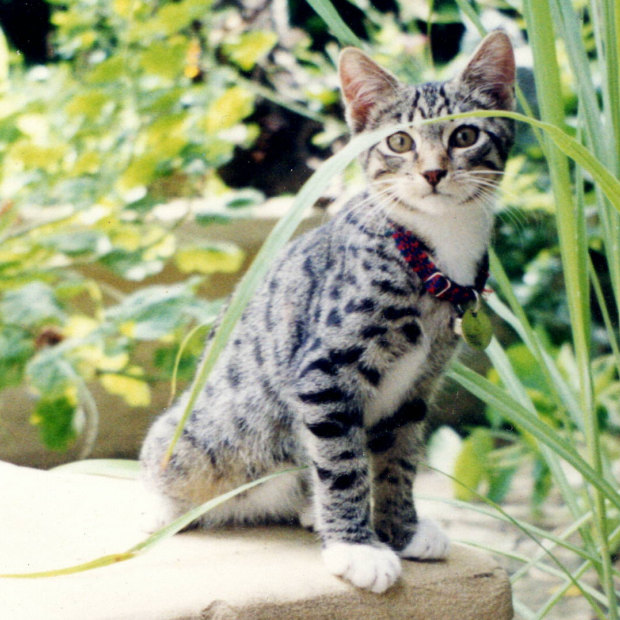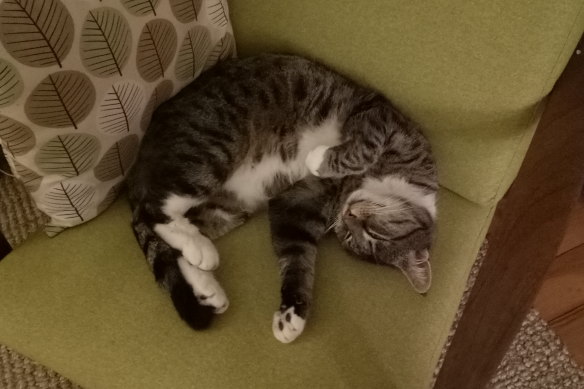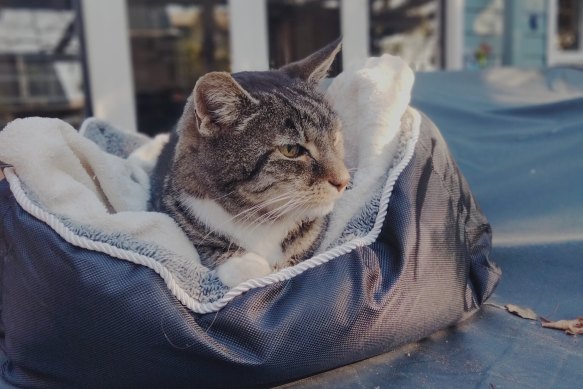This was published 1 year ago
Angel of mercy, or executioner? The existential angst involved in putting down a pet
Euthanising a beloved feline sparks thoughts of the line between owner and guardian – and about who gets to choose when to go, and who doesn’t.

The author’s cat Merlon liked to position himself for pats from passers-by.Credit: Fenella Souter
Our cat died recently. I wish it could have been entirely of his own accord. The beginning of the end came on a weekday, around lunchtime, when we heard a loud yowling out on the street. In itself, that wasn’t unusual. Merlon was a sociable cat who liked to make his presence known. There was something unearthly in this cry, though, and I found him crouched under a parked truck, a dazed look on his face. When he saw me, he kept up the crying but didn’t move.
It turned out he couldn’t move. Back in the house, it was clear that he was in pain. He lay on the sofa, staying where I’d put him for once, his back legs strangely limp, his heart pumping. He wore that faraway expression animals get when they’re in shock and hurting. We’ll never know what happened: we didn’t hear a cat fight, a barking dog, the squeal of a car. We just knew he was in a bad way, this dear old tabby.
At the vet, he was shown the unfeigned kindness vets and their staff seem to excel at, unlike a lot of human doctors and their staff, trained instead to keep a safe, professional distance from suffering. Perhaps it’s easier to express emotion and tenderness towards uncomplaining animal patients.
The vet gave him something straight away for the pain. The X-rays didn’t reveal any breaks or dislocations, just confirmed his ancient arthritic hips, bad “knees” and an old fracture of some sort; the war wounds of a long life. None of that explained the paralysis – maybe a clot, the vet suggested, or a tumour or nerve damage. Hard to tell without doing MRIs and other tests.
An injured or sick human, regardless of age, would have had those tests, no matter the prognosis, the cost or the can of worms they might open. Here, the question was simpler. Was there any point in doing the tests, because then what? He was probably too old to survive a major operation. Too old to heal well if he did. There was also the cost. And, of course, here at the vet’s, there was a painless alternative available that spoke of mercy.
Sometime during that first visit, when I’d composed myself – I’d been embarrassed to find myself in hiccupping tears as I tried to relay the events of the day – the vet asked if we would consider “going down the euthanasia path”, if it came to that. The mention, so early on, suggested it would come to that. Or maybe she could tell I wasn’t one of those owners prepared to go to any lengths to keep a paralysed, 19-year-old pet alive.
I was, however, new to the question she put. From childhood on, I’ve shared my life with many companion animals – “owned many pets”, as we used to say – yet I’ve never had to make the decision to end the life of one. Natural causes, accidents, disappearances have seen the others depart. Their deaths have always been out of my hands or, in the case of farm animals, out of my sight.

“Everyone knew him. He was a master of feline manipulation.”Credit: Fenella Souter
I support voluntary euthanasia for humans, the right to choose one’s going. I support it for pets, too. In their case, however, there’s really nothing voluntary about it. There’s no way of knowing if they agree they should be “put out of their misery”, or if they’d prefer to hang around, no matter what, and see it through, carried around in a little pram for the rest of their lives and possibly in pain.
In that sense, we are their “owners” because we get to decide. But as a friend will remind me, “At least it’s a better end than most humans get.” Certainly, the animal euthanasia path, unlike ours, is not littered with obstacles to compassion. The exit is right there. Does that mean we think less of animals, or more?
After his X-rays, we took him home, feeling very doting towards him. The vet advised us to keep an eye on his appetite, urination and so on. We’d been given syringes of painkillers for him and something for “anxiety” – his. He had a little bandage on one paw where a catheter had been inserted. Printed with little blue cat-paws, it was heartbreakingly cute. He lay doped up
in his cat bed, his chin resting on the side, for once not peskily wanting to go in or out, or anywhere. He was quiet, detached, adorable.
Merlon had had about as long and perfect a life as a cat could have without having his own TikTok account. Still …
He didn’t improve as time passed. He yowled in pain if you tried to move him. He wasn’t himself. On the other hand, he was still very much alive.
We made another visit to the vet to report his lack of progress, no eating, no peeing. She didn’t try to sway us but it was clear she felt the best course, given all the indicators, was to “put him down”, not that she used that term. The alternative prospect was months of vet visits and indignities, pain, and the loss of most of the things he loved to do. It was possible he would never regain the use of his back legs or be able to pee without someone – me, or the vet – expressing his bladder. Even before the incident, he had been creaking around on arthritic hips and was almost deaf. All in all …
He’d had a garden to roam in all his life. He’d had us, his devoted, sometimes exasperated, slaves. He’d established himself as top cat in the street. A shameless attention-seeker, he liked to position himself in strategic spots at key times of the day, to maximise patting from the local schoolkids or passing commuters. Everyone knew him. He was a master of feline manipulation. He’d made himself a regular in the house of at least one other obliging neighbour; they had a lambswool rug set up. In other words, he’d had about as long and perfect a life as a cat could have without having his own TikTok account. Still …
We made an appointment with the vet to return later. There seemed no point in putting it off now. Yet how hard it was, back home, knowing the precise date and time of execution. The wretched weight of knowing these were his last hours, because we had decreed them to be. The guilt. The finality.

Merlon’s final hours at home were spent in the late afternoon sun, looking out on the garden and sniffing scents on the breeze.Credit: Fenella Souter
It was a fine day and I lifted him on his bed onto the outdoor table where he could look out on the garden, feel the late afternoon sun and sniff the breeze for one last time. He was still doped up but he lifted his head and twitched his nose as scents floated past. He felt warm and soft. Here was life, still pulsing. What were we about to do? It would have been so much easier if he’d been in a coma.
In the end, it seemed that this was what love was. To do the hard thing, the thing that was best for him, not for us or an easy conscience. To be not his owner or his needy companion, but his guardian. To be an angel of mercy, even if felt like being an executioner.
Vets must be accustomed to sobbing humans in their surgeries, humans who tell their companion animals, in those final moments, how noble they have been, how loved, how much they will be missed. It is grief, certainly,
although I disagree with those people who insist that losing a pet is “like losing a member of the family”. I’ve lost members of the family and this doesn’t compare. It is sad, wrenching and of course you will sorely miss the familiar presence, but not like you miss a human you’ve loved.
That doesn’t mean it was easy. He’d been a regular fixture in the household for decades, a handsome if demanding face at the back door, a slinking grey panther in the grass. As he lay on the surgery table, the most placid he had ever been at the vet’s, it was tempting to cry “Stop!” like a late objector at a wedding. We didn’t. The vet gave him the sedation and his eyes clouded over. With quiet grace, she asked if we were ready for her to give the final, fatal injection.
The green liquid ran down the tube into an unsuspecting vein, and that was that. If only our own passing could be as swift and unknowing. Without a murmur or a twitch, he crossed the border all living creatures must cross sooner or later, that mysterious line between being and not being.
To read more from Good Weekend magazine, visit our page at The Sydney Morning Herald, The Age and Brisbane Times